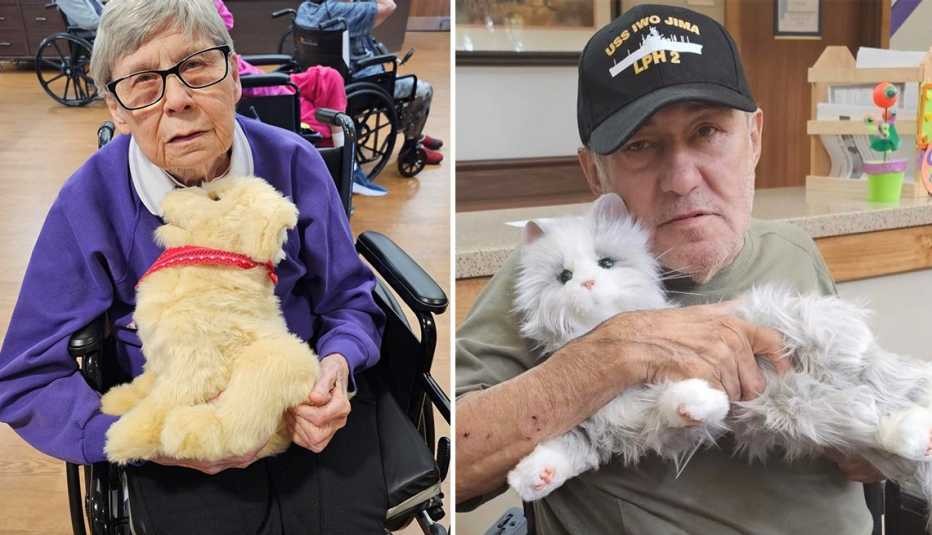Robotic Pets are emerging as a source of comfort and therapeutic benefits, particularly for elderly individuals facing conditions like memory loss, dementia, and depression. Organizations like the U.S. Department of Veterans Affairs (VA) have witnessed firsthand the positive impact these animatronic companions can have. At the Salisbury VA Community Living Center in North Carolina, robotic pets have been instrumental in providing “comfort, connection and therapeutic benefits to veterans with memory loss, dementia and depression,” as reported by the VA in 2022. The simple act of nurturing a robotic pet can have a calming effect on patients, highlighting the potential of these artificial animals in care settings.
The positive effects of robotic pets are not just anecdotal; numerous studies corroborate these benefits. An eight-month study conducted by the University of Plymouth across eight care facilities in Cornwall, England, revealed significant findings. Published in September 2022, the study indicated that residents interacting with mechanical pets experienced a “decreased in neuropsychiatric symptoms,” including delusions and depression, compared to their counterparts without robotic animal companions. This research underscores the tangible mental health benefits that robotic pets can offer.
 two residents of a texas state veterans home iris pierce holding a robotic dog on her lap and gerardo soleto cuddling a robotic cat
two residents of a texas state veterans home iris pierce holding a robotic dog on her lap and gerardo soleto cuddling a robotic cat
Further solidifying these findings, a 2022 study in the Journal of Holistic Nursing explored the impact of robotic pets on individuals with dementia. Over six weeks, 18 men and women with dementia in a Northeastern U.S. residential care facility interacted with robotic cats and dogs. The study reported a “significantly reduced” sense of loneliness and a “significant improvement” in depression among the participants. These results suggest that robotic pets can play a crucial role in alleviating feelings of isolation and enhancing mood in dementia patients.
Beyond emotional support, robotic pets can also stimulate cognitive function. A 2021 study from Florida Atlantic University found that dementia patients who interacted with robotic cats exhibited improved moods. Caregivers observed that many residents found comfort in sleeping with their robotic cats. Moreover, over half of the participants showed slight to moderate improvements in cognitive areas such as attention and language. Researchers noted that participants frequently engaged in conversations with their robotic pets, indicating a form of mental engagement. The VA also highlights that mechanical animals can facilitate reminiscence therapy, helping individuals recall and converse about past memories, particularly childhood pets.
For those considering acquiring a robotic pet for a loved one, several options are available. Ageless Innovation is a prominent manufacturer of companion animals used by various organizations. Their robotic dogs and cats are typically priced between $100 and $140, while robotic birds are around $47 on major retail websites. Alternative products include MetaCat, a more advanced robotic cat priced at $189, known for its realistic movements and sounds, and Perfect Petzzz, offering battery-operated, “breathing” synthetic fur cats and dogs for approximately $40.
Another avenue to explore is contacting state or county agencies on aging. Some agencies distribute robotic pets to residents free of charge. For instance, in Washington state, senior services agencies have distributed over 700 robotic dogs and cats to older adults experiencing dementia or loneliness. Similarly, the New York State Office for the Aging distributed around 4,000 animatronic pets during the pandemic and plans to provide an additional 17,000 in the coming years through local agencies.
It is important to acknowledge that while robotic pets offer numerous benefits, they are not a universal solution, especially for individuals with dementia. Monica Moreno, senior director of care and support at the Alzheimer’s Association, advises that responses to robotic pets can vary significantly. Success depends on understanding an individual’s personal history and preferences. “It’s about connecting with the person where they’re at, trying to see the world through their eyes and understanding what they are feeling, and then identifying the best approach to provide comfort,” Moreno explains. For someone with a past negative experience with animals, a robotic pet could be counterproductive, potentially increasing anxiety instead of providing comfort. Conversely, intense attachment to a robotic pet could also lead to anxiety if the pet is lost. Therefore, a thoughtful and personalized approach is crucial when considering robotic pets for elderly loved ones.